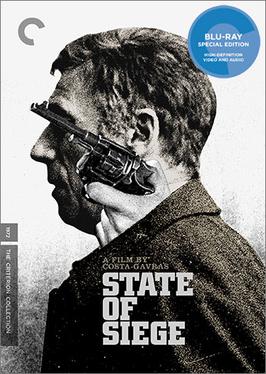Top Qs
Timeline
Chat
Perspective
State of Siege
1972 film From Wikipedia, the free encyclopedia
Remove ads
State of Siege (French: État de siège) is a 1972 French–Italian–West German political thriller film directed by Costa-Gavras starring Yves Montand and Renato Salvatori. The story is based on an actual incident in 1970, when U.S. official Dan Mitrione was kidnapped and later killed by an urban guerrilla group in Uruguay.[3][4]
Remove ads
Plot
Philip Michael Santore, an official of the United States Agency for International Development, is found shot in a car after an extensive raid by police and military forces. In a flashback which takes up almost the entire film, State of Siege tells of his kidnapping by the Tupamaro guerrilla group, whose members confront him with his involvement in the training of the Uruguayan, Brazilian, and Dominican police, including interrogation techniques and torture to be used on opponents of the authoritarian regime. The Tupamaros demand the release of all political prisoners from the government in exchange for Santore, but the government declines. When a large number of the group's members are arrested, the remaining fraction decides to kill their hostage. The final scene shows the arrival of a new U.S. official to replace Santore.
Remove ads
Cast
- Yves Montand as Philip Michael Santore
- Renato Salvatori as Captain Lopez
- O. E. Hasse as Carlos Ducas
- Jacques Weber as Hugo
- Jean-Luc Bideau as Este
- Maurice Teynac as Minister of Internal Security
- Yvette Etiévant as Woman Senator
- Evangeline Peterson as Mrs. Santore
- Harald Wolff as Minister of Foreign Affairs
- Nemesio Antúnez as President Jorge Pacheco Areco
- Mario Montilles as Assistant Commissioner Fontant
- André Falcon as Deputy Fabbri
- Jacques Perrin as Telephone operator
- Juan Guzmán Tapia as Journalist (uncredited)
Remove ads
Production
Though the setting of State of Siege is never explicitly named, signages throughout the film refer to Montevideo, and the Tupamaros are mentioned by name. Costa-Gavras, living in Paris at the time and preparing his film The Confession, had learned of Mitrione's case in French newspaper Le Monde and decided to make further investigations in Uruguay himself, accompanied by screenwriter Franco Solinas (The Battle of Algiers).[3][4] The film was shot in Chile during the brief democratic socialist rule of Salvador Allende, just before the 1973 Chilean coup d'état, which Costa-Gavras would dramatise in his later film Missing.[4] Although Allende supported Costa-Gavras' project, the director faced opposition both from Chilean Communist Party members and the conservative mayor of Santiago Province commune Las Condes during filming.[5]
The role of the government's president is played by Chilean painter Nemesio Antúnez.[6]
Release and reception in the US
State of Siege became the subject of controversial discussions upon its US release.[5] Smith Hempstone claimed the film falsely indicted the US and Ernest W. Lefever wrote that it presented a "profoundly fraudulent" portrait of Mitrione.[5][7] A planned screening during a festival organised by the American Film Institute in the John F. Kennedy Center, Washington, D.C., in April 1973, was cancelled by the AFI's director George Stevens, who argued that the film "rationalizes an act of political assassination".[8][9] Protesting Stevens' decision, twelve filmmakers, including François Truffaut, withdrew their films from the festival.[8] Writing in the New York Times, John F. Kennedy's former staff member Theodore Sorenson described State of Siege as a simplistic but "important film", which he hoped would awaken viewers from their "slumbering indifference" to Latin America.[5]
For The New Yorker, Pauline Kael wrote that the film was a "political argument on a conscious level" where "the youthful, idealistic Tupamaros and the old fat-cat government men and businessmen are almost cartoons of good and evil."[10]
Remove ads
Awards
References
Further reading
External links
Wikiwand - on
Seamless Wikipedia browsing. On steroids.
Remove ads

